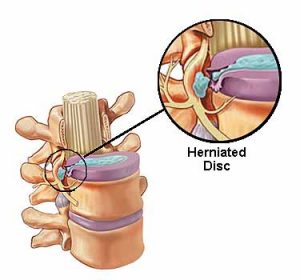Herniated Disc Management
What is a Herniated Disc?
 Herniated discs are probably the most common diagnosis for severe back pain and sciatica (leg pain). Discs are large cushions that lie between the individual vertebrae of our spinal columns. The disc composes of layers of ligaments (annulus fibrosis) arranged in a criss-crossing matri. It holds in a gel-like substance (nucleus pulposus), giving the disc its “shock-absorbing” ability. Sometimes the gel swells (which is also known as a disc protrusion or bulge). A more problematic situation occurs if the gel pushes through its ligamentous wall (which is a disc prolapse or extrusion). Both situations can lead to pressure or irritation of the vulnerable spinal nerve roots. This can lead to sciatica–an abnormal sensation felt anywhere from the buttocks to the feet.
Herniated discs are probably the most common diagnosis for severe back pain and sciatica (leg pain). Discs are large cushions that lie between the individual vertebrae of our spinal columns. The disc composes of layers of ligaments (annulus fibrosis) arranged in a criss-crossing matri. It holds in a gel-like substance (nucleus pulposus), giving the disc its “shock-absorbing” ability. Sometimes the gel swells (which is also known as a disc protrusion or bulge). A more problematic situation occurs if the gel pushes through its ligamentous wall (which is a disc prolapse or extrusion). Both situations can lead to pressure or irritation of the vulnerable spinal nerve roots. This can lead to sciatica–an abnormal sensation felt anywhere from the buttocks to the feet.
Are bed rest and surgery necessary?
For more than 50 years, orthopedists have believed that herniated discs caused most lower back pain and sciatica. The “dynasty of the disc” led to the typical medical advice of bed rest and medication. Gordon Waddell, a renowned British orthopedic surgeon, wrote in the journal Spine, “There is remarkably little scientific or clinical evidence to support the value of bed rest for low back pain or even sciatica.” Bed rest is now known to cause prolonging pain, muscle weakness, joint stiffness, and depression.
If bed rest failed, surgery was the usual next step. Unfortunately, due to poor patient selection, many unnecessary surgeries were performed. Waddell said, “surgical successes unfortunately only apply to approximately one percent of patients with low back pain.” According to Alf Nachemson, M.D., editor of the journal Spine,“bulging discs are found and taken as an excuse to do a lot of surgery and percutaneous discectomy. Discs are made to bulge; that is a normal finding.”
Back and even leg pain can arise from the muscles, joints, or ligamentous structures of the spine. Whatever the cause, evidence is growing showing that rehabilitation not surgery is the treatment of choice for most lower back disorders.
What treatments have been proven to work?
A recent study from a leading orthopedic center in San Francisco demonstrated that more than 90% of patients with disc herniation responded to non-surgical treatment. Most of these patients had already been referred by neurologists for immediate surgery. Their treatment included simple pain control methods in combination with rehabilitation. According to Nachemson, “All the structures in the back fare better with early, controlled motion. . . if something is injured and you start to slowly move it under controlled conditions, then the structure heals quicker and better.”
Conservative and surgical treatments
For lumbar and cervical herniated discs, conservative (non-surgical) treatments can usually be applied for around four to six weeks to help reduce pain and discomfort. A process of trial and error is often necessary to find the right combination of treatments. Patients may try one treatment at a time or may find it helpful to use a combination of treatment options at once. For example, treatments focused on pain relief (such as medications) may help patients better tolerate other treatments (such as manipulation and mobilization).
 In addition to helping with recovery, therapy is often used to educate patients on good body mechanics (such as proper lifting technique) which helps to prevent excessive wear and tear on the discs. For those patients who experience severe pain and a high loss of function and don’t find relief from conservative treatments, surgery may be a considering option. However, conservative therapy is always the first option.
In addition to helping with recovery, therapy is often used to educate patients on good body mechanics (such as proper lifting technique) which helps to prevent excessive wear and tear on the discs. For those patients who experience severe pain and a high loss of function and don’t find relief from conservative treatments, surgery may be a considering option. However, conservative therapy is always the first option.
The different conservative and surgical treatment options for lumbar and cervical herniated discs are described below.
Conservative treatments for lumbar and cervical herniated discs
A combination of the following conservative treatment options can be used through at least the first six weeks of discomfort and pain:
- Massage therapy, exercise and gentle stretching to help relieve pressure on the nerve root
- Ice and heat therapy for pain relief
- Mobilization and Manipulation (i.e. chiropractic adjustments if indicated)
- Non-steroidal anti-inflammatory drugs (NSAIDs) such as ibuprofen, naproxen or COX-2 inhibitors for pain relief
- Narcotic pain medications for pain relief
- Oral steroids to decrease inflammation for pain relief in severe cases
- Epidural injections to decrease inflammation for pain relief
Conclusion to successful treatment of a herniated disc
Treatment of a herniated disc is complicated because of the individualized nature of each patient’s pain and symptoms. A treatment option that relieves pain and discomfort for one patient may not work for another. By working with your Health Care Professional, you can find the best combination of treatment. There are many options for their pain and can avoid having surgery too soon or too late.
